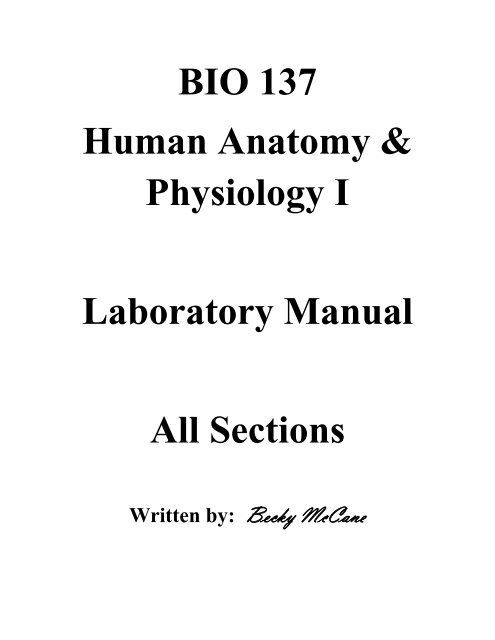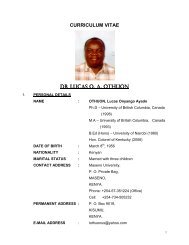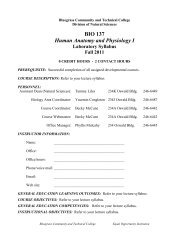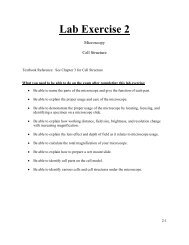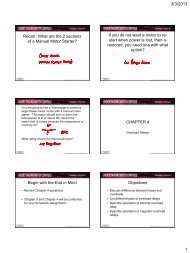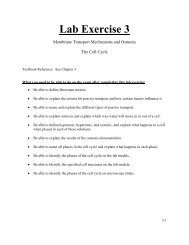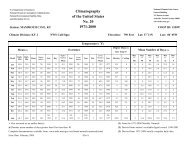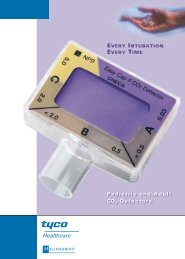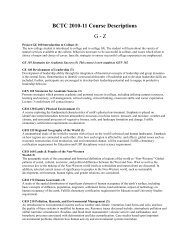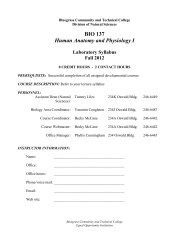BIO 137 Human Anatomy & Physiology I Laboratory Manual All ...
BIO 137 Human Anatomy & Physiology I Laboratory Manual All ...
BIO 137 Human Anatomy & Physiology I Laboratory Manual All ...
You also want an ePaper? Increase the reach of your titles
YUMPU automatically turns print PDFs into web optimized ePapers that Google loves.
<strong>BIO</strong> <strong>137</strong><br />
<strong>Human</strong> <strong>Anatomy</strong> &<br />
<strong>Physiology</strong> I<br />
<strong>Laboratory</strong> <strong>Manual</strong><br />
<strong>All</strong> Sections<br />
Written by: Becky McCane
Textbook Reference: See Chapter 1<br />
Lab Exercise 1<br />
Measurements<br />
Body Organization<br />
Body Systems<br />
What you need to be able to do on the exam after completing this lab exercise:<br />
Be able to convert from one metric unit to another.<br />
Be able to explain what each metric base unit measures.<br />
Be able to convert large and small numbers to scientific notation.<br />
Be able to convert scientific notation to large (or small) numbers.<br />
Be able to identify directional terms on the muscle man model and the skin model.<br />
Be able to identify each body plane on a diagram and organ.<br />
Be able to identify all specified regions on the baby doll.<br />
Be able to identify the major body organs on a torso model.<br />
Be able to identify each body cavity on the torso model and know which major organs are<br />
housed within each cavity.<br />
Be able to identify the abdominopelvic quadrants and regions on a torso model.<br />
Be able to identify the correct body systems and organs on the models or diagrams.<br />
1-1
Metric Measurement<br />
Measurements<br />
In the <strong>BIO</strong> <strong>137</strong> lab, the metric system of measurement is used. It is important to be able to<br />
convert from one metric unit to another.<br />
We will be using 3 base units: gram (to measure mass)<br />
meter (to measure distance)<br />
liter (to measure volume)<br />
Below is a table that gives you the base units in the center, larger units to the left of center, and<br />
smaller units to the right of center.<br />
To convert from a smaller unit to a larger unit, you simply need to move your decimal point<br />
to the left the required number of places.<br />
To convert from a larger unit to a smaller unit, you move your decimal point to the right the<br />
required number of places.<br />
mega- kilo- hecto- deca- base unit deci- centi- milli- micro- nano-<br />
(M) (k) (h) (da) gram (g) (d) (c) (m) (µ) (n)__<br />
1,000,000 1000 100 10 liter (L) 0.1 0.01 0.001 0.000001 0.000000001<br />
10 6 10 3 10 2 10 1 meter (m) 10 -1 10 -2 10 -3 10 -6 10 -9<br />
46 mm = ____ m<br />
To convert from mm to m, move your decimal point 3 places to the left (since the base unit is<br />
three places to the left of milli- on the chart).<br />
46 mm = .046 m<br />
400 cg = ____ mg<br />
To convert from cg to mg, move your decimal point 1 place to the right (since milli- is 1 place to<br />
the right of centi- on the chart).<br />
400 cg = 4,000 mg<br />
1-2
Practice. Convert the following:<br />
1. 25 mL = __________ dL 5. 3,500 mm = __________ m<br />
2. 15 g = __________ mg 6. 0.005 km = __________ m<br />
3. 750 g = __________ kg 7. 250 cL = __________ mL<br />
4. 275 mm = __________cm 8. 6,750 cg = __________ kg<br />
Scientific Notation<br />
Scientists often deal with very small and very large numbers. This can be confusing due to<br />
counting all those zeros! To simplify these numbers, we have learned to express them as powers<br />
of 10.<br />
Positive exponents indicate a number larger than zero.<br />
Negative exponents indicate a number smaller than zero.<br />
Convert 1,500,000 to scientific notation.<br />
We move the decimal point so there is only ONE digit to its left (which is a total of 6 places to<br />
the left in this example).<br />
1,500,000 = 1.5 x 10 6<br />
Convert 0.000025 to scientific notation.<br />
We move the decimal point again so there is only ONE digit to its left (which is a total of 5<br />
places to the right in this example).<br />
0.000025 = 2.5 x 10 -5<br />
Practice. Convert the following to scientific notation.<br />
1. 0.005 = ________________ 4. 500 = _________________<br />
2. 5,050 = ________________ 5. 0.0025 = _______________<br />
3. 0.0008 = _______________ 6. 0.25 = _________________<br />
Practice. Convert the following to standard notation.<br />
1. 1.5 x 10 3 = ___________ 4. 1.2 x 10 -4 = __________<br />
2. 1.5 x 10 -3 = ___________ 5. 1 x 10 4 = ____________<br />
3. 3.75 x 10 2 = ___________ 6. 4 x 10 0 = ____________<br />
1-3
Anatomical Position<br />
Body Organization<br />
In <strong>Human</strong> <strong>Anatomy</strong> & <strong>Physiology</strong>, we refer to the body parts in relation to a person standing in<br />
the anatomical position.<br />
Criteria:<br />
Standing Erect<br />
Facing Forward<br />
Arms at Sides<br />
Palms Forward<br />
Feet Slightly Apart<br />
1-4
Directional Terminology<br />
When comparing the location of one body part to another, we use directional terms.<br />
Know the following directional terms on Muscle Man:<br />
A is Superior to B F & G are Ipsilateral (on the same side)<br />
B is Inferior to A J & A are Contralateral (the opposite sides)<br />
B is Anterior to D (on back side) G is Proximal to H<br />
D is Posterior to C H is Distal to G<br />
E is Medial to F (on side of leg) G is Intermediate to H & K<br />
F is Lateral to E 1-5
Planes of Reference<br />
Know the following planes of reference on a diagram or organ:<br />
A Frontal plane divides the body or an organ into Anterior/Posterior halves.<br />
A Median (Midsagittal) plane divides the body or an organ into equal Left/Right halves.<br />
A Transverse plane divides the body or an organ into Superior/Inferior halves.<br />
Midsagittal Section of Sheep Brain<br />
1-6
Frontal (Coronal) Section of Sheep Brain<br />
Transverse Section of Sheep Brain<br />
1-7
Regional Terminology<br />
In <strong>Human</strong> <strong>Anatomy</strong> & <strong>Physiology</strong>, we use scientific terms for various regions of the body.<br />
Know the following regional terms on the baby doll:<br />
1-8
1-9
Major Body Organs<br />
Know the following organs on the torso model:<br />
A. Larynx E. Stomach<br />
B. Lung G. Small Intestine<br />
D. Liver H. Large Intestine<br />
1-10
B. Lung I. Kidney<br />
C. Heart J. Adrenal Gland<br />
F. Pancreas K. Urinary Bladder<br />
1-11
Body Cavities<br />
Body cavities are open areas in the body that usually house an organ, bone, or other body part.<br />
Know the following body cavities.<br />
1-12
The diagram below lists the organs housed within the body cavities.<br />
In addition to the information above:<br />
The Pleural cavities house the lungs.<br />
The Pericardial cavity houses the heart.<br />
1-13
Abdominopelvic Quadrants<br />
In <strong>Human</strong> <strong>Anatomy</strong> & <strong>Physiology</strong>, we sometimes divide the abdominopelvic cavity into<br />
quadrants to make studying the cavity easier.<br />
Know the following body quadrants:<br />
1-14
Abdominopelvic Regions<br />
In <strong>Human</strong> <strong>Anatomy</strong> & <strong>Physiology</strong>, we sometimes divide the abdominopelvic cavity into nine<br />
regions to make studying the cavity easier.<br />
Know the following abdominopelvic regions:<br />
1-15
Body Systems<br />
For each of the following body systems, know the organs that are listed and to which body<br />
system those organs belong:<br />
Integumentary System<br />
Know the parts of the Integumentary System (listed below) on the skin model in the lab.<br />
A. Epidermis D. Hair<br />
B. Dermis E. Sebaceous Gland<br />
C. Hypodermis F. Sweat Gland<br />
More Directional Terms on Skin Model:<br />
A is Superficial to B<br />
B is Deep to A 1-16
Skeletal System<br />
Know the parts of the Skeletal System (listed below the picture) on the knee joint model in lab.<br />
A. Bone (femur, tibia, fibula on diagram)<br />
B. Ligament (1, 2, 3, 4, 5 on diagram)<br />
C. Cartilage (6 & 7 on diagram)<br />
1-17
Muscular System<br />
Know the parts of the Muscular System (listed below the picture) on the muscle man model in<br />
the lab.<br />
A. Muscle (red on diagram)<br />
B. Tendon (grayish white on diagram)<br />
1-18
Nervous System<br />
Know the parts of the Nervous System (listed below the picture) on the nerve man model in the<br />
lab.<br />
A. Brain (in skull)<br />
B. Spinal Cord (extends from brain)<br />
C. Peripheral Nerves (yellow on diagram; extend from brain/spinal cord)<br />
1-19
Endocrine System<br />
Know the listed glands of the Endocrine System on the model board in the lab.<br />
1. Pituitary Gland 13. Pancreas<br />
5. Thyroid Gland 16. Testis<br />
8. Parathyroid Gland 20. Ovary<br />
9. Adrenal Gland<br />
You will not need to know the Pineal Gland for the first lab exam. It will be covered when we<br />
study the brain.<br />
1-20
Cardiovascular System<br />
Know the organs of the Cardiovascular System (listed below the picture) on the heart model in<br />
the lab.<br />
A. Heart<br />
B. Aorta (large red vessel extending from top of heart)<br />
C. Arteries<br />
D. Veins<br />
1-21
Lymphatic System<br />
Know the following parts of the Lymphatic System on the diagram displayed in the lab.<br />
Note: The diagram in the lab looks different from this one, but has the same organs.<br />
A. Lymph Nodes<br />
B. Lymph Vessels<br />
C. Spleen<br />
D. Thymus<br />
You do not need to know “Tonsil”<br />
1-22
Respiratory System<br />
Know the parts of the Respiratory System (listed below the picture) on the respiratory system<br />
model in the lab.<br />
A. Larynx<br />
B. Trachea<br />
C. & D. Lungs<br />
Bronchi (branches of trachea, not shown in picture)<br />
1-23
Digestive System<br />
Know the parts of the Digestive System (listed below the picture) on the digestive system model<br />
in the lab.<br />
1. Teeth 12. Liver<br />
6. Esophagus 13. Small Intestine<br />
7. Stomach 15a. Ascending Colon<br />
9. Pancreas 15b. Transverse Colon<br />
11. Gallbladder 15c. Descending Colon<br />
1-24
Urinary System<br />
Know the parts of the Urinary System (listed below the picture) on the urinary system model in<br />
the lab.<br />
12. Kidney<br />
24. Ureter<br />
37. Urinary Bladder<br />
Urethra<br />
1-25
Male Reproductive System<br />
Know the parts of the Male Reproductive System (listed below the picture) on the male<br />
reproductive system model in the lab.<br />
1. Penis 52. Testes<br />
3. Scrotum 53. Epididymis<br />
38. Seminal Vesicle Vas Deferens<br />
(on diagram displayed in lab)<br />
40. Prostate Gland<br />
1-26
Female Reproductive System<br />
Know the parts of the Female Reproductive System (listed below the model) on the female<br />
reproductive system model in the lab.<br />
20. Fallopian Tubes<br />
21. Ovary<br />
22. Uterus<br />
29. Vagina<br />
1-27


